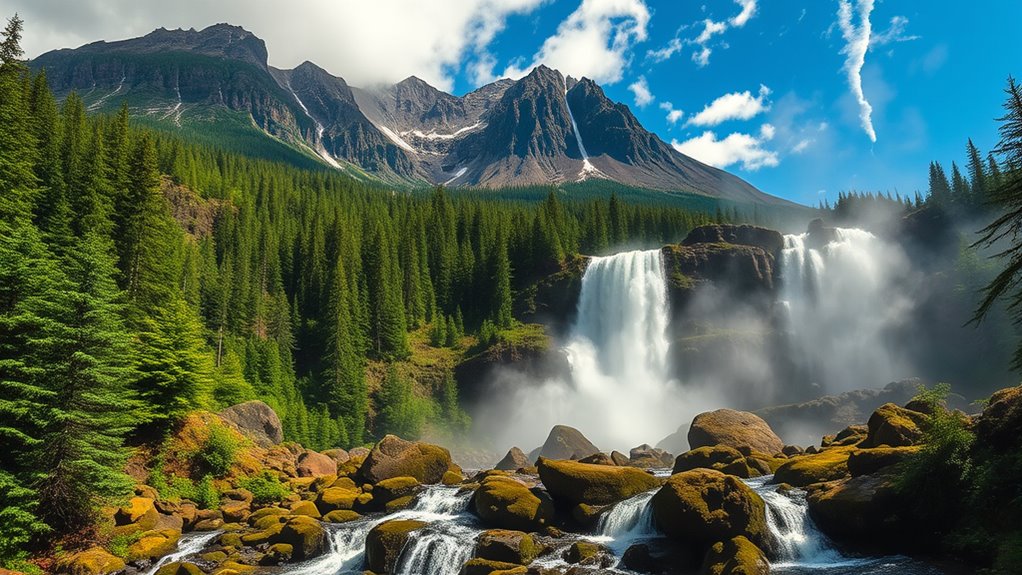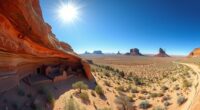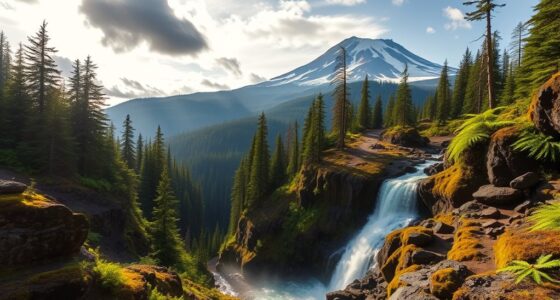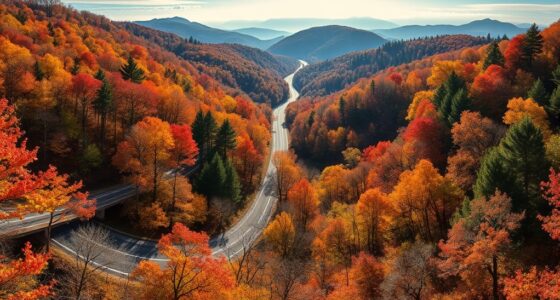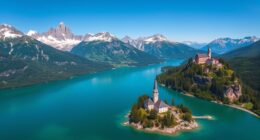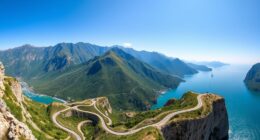Oregon’s Volcanoes and Waterfalls Circuit takes you on an exciting journey through iconic landmarks like Mount Hood, the Three Sisters, and Crater Lake, showcasing the state’s powerful volcanic history. You’ll explore stunning waterfalls such as Multnomah Falls and hidden cascades, alongside unique volcanic landscapes like Newberry National Volcanic Monument. Discover how volcanic activity shaped the land and the vibrant ecosystems it supports. Continue exploring to uncover even more natural marvels on this incredible circuit.
Key Takeaways
- Oregon’s Volcanoes, including Mount Hood and the Three Sisters, showcase dynamic volcanic formations and ongoing geological activity.
- Crater Lake, formed by a volcanic caldera, is a deep blue lake with rich legends and high mineral content.
- Iconic waterfalls like Multnomah Falls and hidden gems such as Ramona and Watson Falls highlight volcanic rock formations and lush ecosystems.
- The Newberry Volcanic Monument features extensive lava fields, underground lava tunnels, and volcanic glass formations.
- Ongoing monitoring and AI-driven research help predict eruptions and study the region’s active volcanic landscape.
Exploring Mount Hood: Oregon’s Iconic Peak
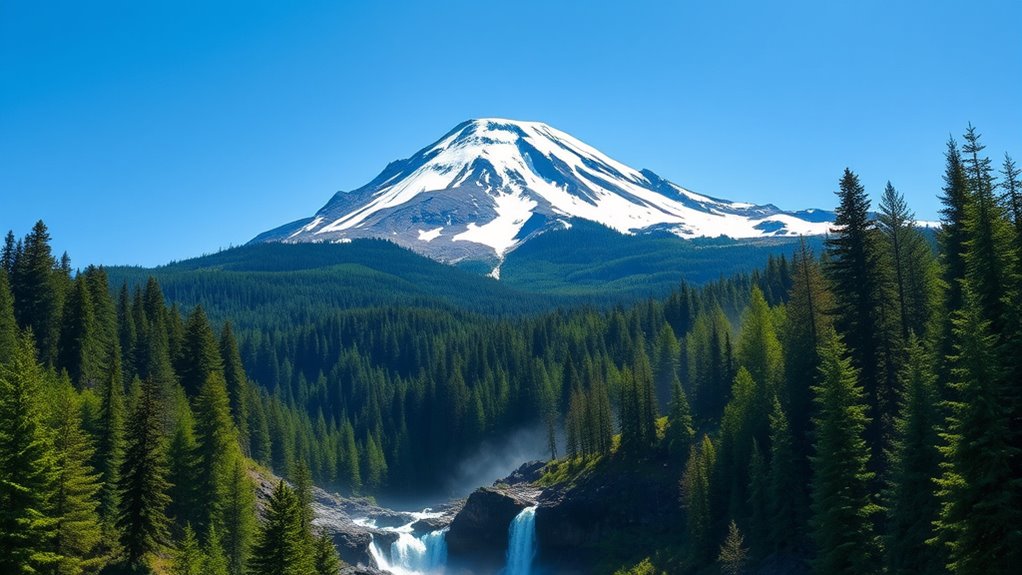
Nestled in the Cascade Range, Mount Hood stands as Oregon’s most iconic peak and a must-visit for outdoor enthusiasts. Its towering presence has inspired many volcano myths, fueling local legends about its fiery past. Geologists reveal that Mount Hood’s impressive geological formations tell a story of volcanic activity spanning thousands of years. You can explore its rugged slopes and discover evidence of past eruptions, which shaped the surrounding landscape. The mountain’s symmetrical cone is a striking example of volcanic formation, created by layers of lava and ash over centuries. The contrast ratio in the volcanic layers highlights the mountain’s dynamic eruptive history. Additionally, the integration of AI-driven insights in geological research is helping scientists better understand volcanic activity and predict future eruptions. This ongoing research enhances our understanding of volcanic processes, leading to improved safety measures for nearby communities. Moreover, the presence of geothermal features around Mount Hood indicates ongoing volcanic activity beneath the surface. In recent years, monitoring technology has been increasingly used to observe signs of potential eruptions. Whether you’re hiking its trails or gazing at its majestic summit, Mount Hood offers a mesmerizing glimpse into the powerful forces of nature that forged Oregon’s volcanic landscape.
The Three Sisters: A Trio of Volcanic Majesty
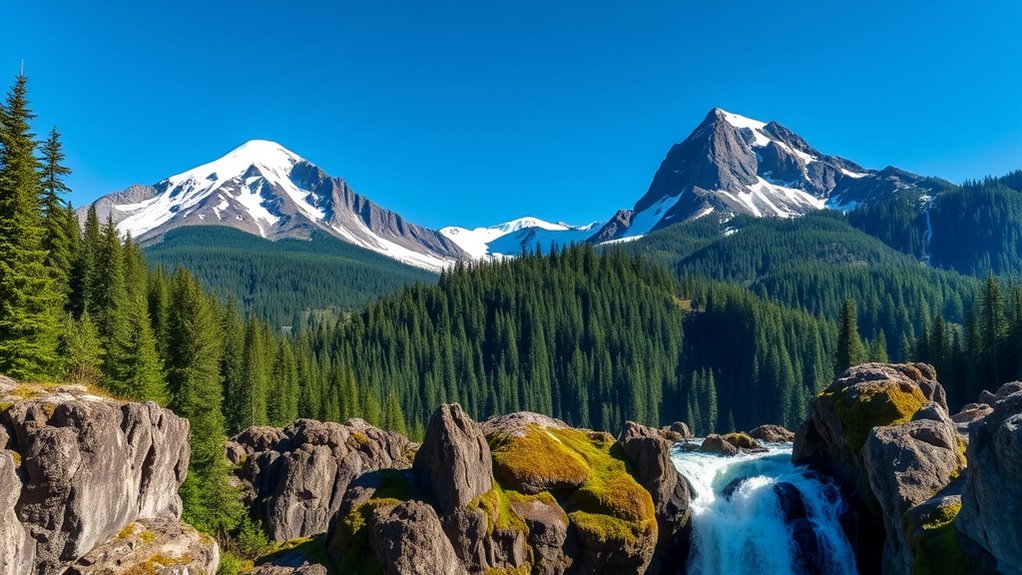
The Three Sisters form a stunning volcanic formation shaped by ancient eruptions and geological forces. You can explore numerous hiking trails that offer spectacular views of these towering peaks. Whether you’re seeking scenic overlooks or close-up encounters, the area provides plenty of viewing spots to enjoy their majestic presence.
Formation and Geology
The Three Sisters form a striking volcanic formation in Oregon’s Cascade Range, created through a series of explosive eruptions and intricate geological processes. Over time, eruptions built up layered lava formations, shaping their distinct peaks. These volcanoes also host rich mineral deposits, evidence of past volcanic activity. Their formation involves complex interactions between magma chambers and tectonic shifts, resulting in diverse volcanic features. The landscape reveals ancient lava flows and cooled volcanic ash that define the region’s geology. You can see how these processes contributed to the area’s volcanic majesty, with each mountain telling a unique geological story. Understanding their formation helps explain the area’s dynamic volcanic history and the ongoing geological activity shaping the landscape today.
- Lava formations and layered eruptions
- Mineral deposits indicating volcanic activity
- Tectonic processes shaping the peaks
Hiking and Viewing Spots
For outdoor enthusiasts, hiking around the Three Sisters offers breathtaking views of these iconic volcanic peaks. Trails wind through diverse landscapes, revealing rich flora diversity and thriving wildlife habitats. As you explore, you’ll see wildflowers dotting the terrain and spot birds and small mammals in their natural environment. The area provides multiple viewing spots, from forested overlooks to open meadows, perfect for capturing photos or simply soaking in the scenery. Whether you’re on a short nature walk or a more challenging hike, the terrain varies, offering something for every skill level. Keep your eyes open for local wildlife, and enjoy the tranquility of the lush surroundings. These spots are ideal for connecting with nature and appreciating the volcanic majesty of the Three Sisters. The use of Natural materials like wood and stone are prevalent in the surrounding environment, enhancing the scenic beauty. Exploring the trail system also allows you to learn about the volcanic activity that shaped this stunning landscape. Additionally, understanding the importance of geological features can deepen your appreciation of the area’s natural history. Incorporating principles like the Law of Attraction can also enhance your experience by fostering a positive mindset and gratitude during your adventure.
Crater Lake National Park: A Deep Blue Wonder
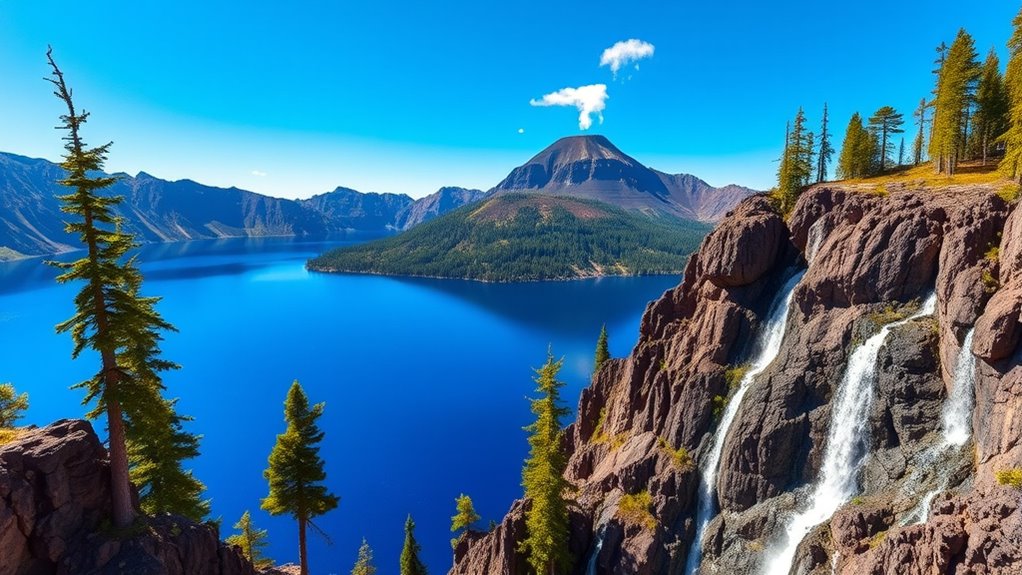
You’ll be captivated by Crater Lake’s crystal-clear blue waters, which create a stunning, almost surreal sight. These waters are steeped in volcanic legends, adding a layer of mystery to your visit. As you explore, you’ll discover why this deep blue wonder remains one of Oregon’s most iconic natural treasures. Additionally, the formation of Crater Lake itself is a testament to volcanic activity, showcasing the power of volcanic processes that shaped the landscape over millennia. The lake’s unique color and clarity are also influenced by its geological composition, which contributes to its pristine appearance. Understanding the volcanic activity and its impact can deepen your appreciation for the lake’s formation and enduring beauty. Moreover, ongoing monitoring techniques help scientists study the volcano’s behavior and ensure the safety of visitors.
Crystal Blue Waters
Crater Lake’s crystal-clear waters captivate visitors with their striking shade of deep blue. This stunning lake, a prime example of glacial lakes, owes its vibrant hue to the purity of its water and mineral deposits from past volcanic activity. As you gaze into the lake, you’ll notice how its clarity reveals the lakebed’s rich mineral content. The lake’s depth enhances its mesmerizing color and creates a sense of awe. You can explore the lake via boat tours or hike along scenic viewpoints. Keep an eye out for:
- The pristine, glacier-fed waters that resist sedimentation, thanks to the lake’s filtration systems that maintain water clarity.
- The unique mineral deposits shaping the lake’s vibrant features
- The tranquil, reflective surface that embodies nature’s untouched beauty
- Understanding the geology and formation of Crater Lake enriches the appreciation of its striking appearance. Learning about the lake’s natural preservation highlights the importance of conservation efforts that maintain its pristine condition. Protecting the lake’s water quality is essential for sustaining its vivid color and ecological health. Additionally, water filtration systems play a crucial role in preserving the lake’s clarity and ecological balance.
Volcanic Legends
Legends surrounding Crater Lake add a mystical aura to its already breathtaking scenery. Local stories speak of mythical creatures that dwell beneath its deep blue surface, guarding secrets from ancient times. These tales often trace back to its volcanic origins, when a massive eruption created the caldera we see today. Some believe the lake is home to spirits or water beings that emerged from volcanic energy, binding the land and water in mysterious ways. Others tell of a giant serpent that once roamed the depths, guarding treasures hidden within. These legends enrich your visit, blending geology with myth, and remind you of the lake’s powerful volcanic past. The formation of the caldera is a dramatic reminder of the volcanic forces that shaped this landscape, fueling these stories with a sense of awe. Additionally, the volcanic activity responsible for the lake’s creation continues to influence its environment, making it a dynamic and evolving natural wonder. The geological history of Crater Lake showcases the ongoing impact of volcanic processes, adding depth to its mythic significance. Crater Lake isn’t just a natural wonder; it’s a land of stories shaped by volcanic origins and mythical creatures. The emotional connection people feel when visiting helps foster a deeper appreciation for the lake’s natural and legendary significance.
Multnomah Falls: The Crown Jewel of Waterfalls
Is there a waterfall more iconic than Multnomah Falls in Oregon? Probably not. This stunning cascade, soaring 620 feet, is framed by volcanic rock formations that add to its dramatic beauty. As you approach, you’ll notice the lush greenery surrounding it, perfect for capturing breathtaking shots. Want great waterfall photography tips? Use a slow shutter speed to smooth the flowing water and highlight its movement. The viewing bridge offers an excellent vantage point for photos, but don’t miss the trail to the top for a panoramic view. The waterfall’s grandeur, combined with its geological significance, truly makes it the crown jewel of Oregon’s waterfalls. Whether you’re snapping pictures or just soaking it all in, Multnomah Falls promises an unforgettable experience.
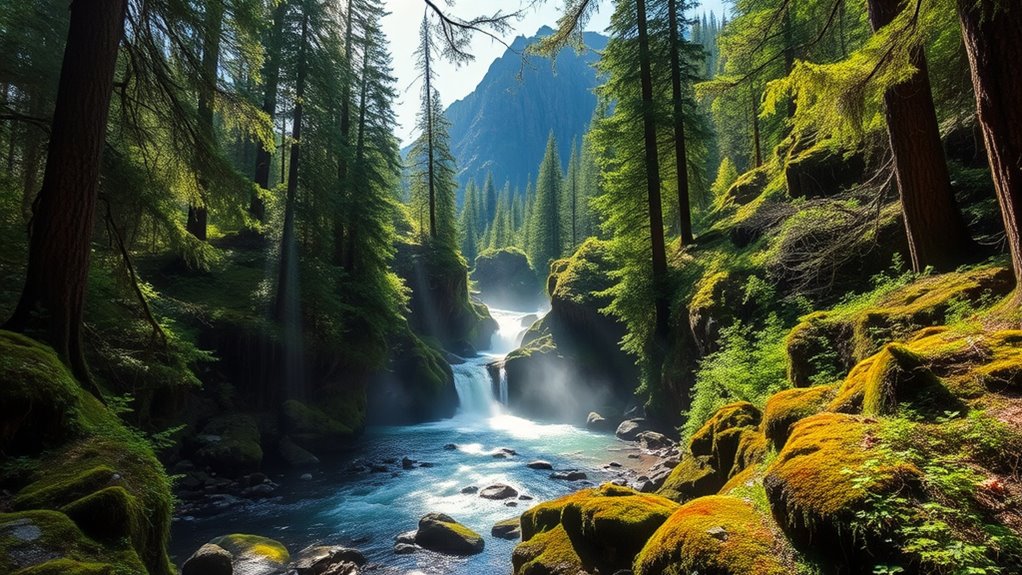
While Oregon’s famous waterfalls draw plenty of visitors, some of the most breathtaking cascades remain hidden beneath the surface, waiting to be discovered by those willing to venture off the beaten path. These hidden gems often require some exploration but reward you with serene, less crowded experiences. Secret cascades like Ramona Falls and Watson Falls showcase nature’s untouched beauty. To help you navigate, here’s a quick guide:
| Hidden Gem | Location |
|---|---|
| Ramona Falls | Mount Hood National Forest |
| Watson Falls | Umpqua National Forest |
| Silver Falls | Silver Falls State Park |
| Proxy Falls | Willamette National Forest |
| Fall Creek Falls | Cascades Range |
Seek these treasures for a more intimate Oregon waterfall adventure.
The Lava Fields and Volcanic Landscapes of Newberry National Volcanic Monument
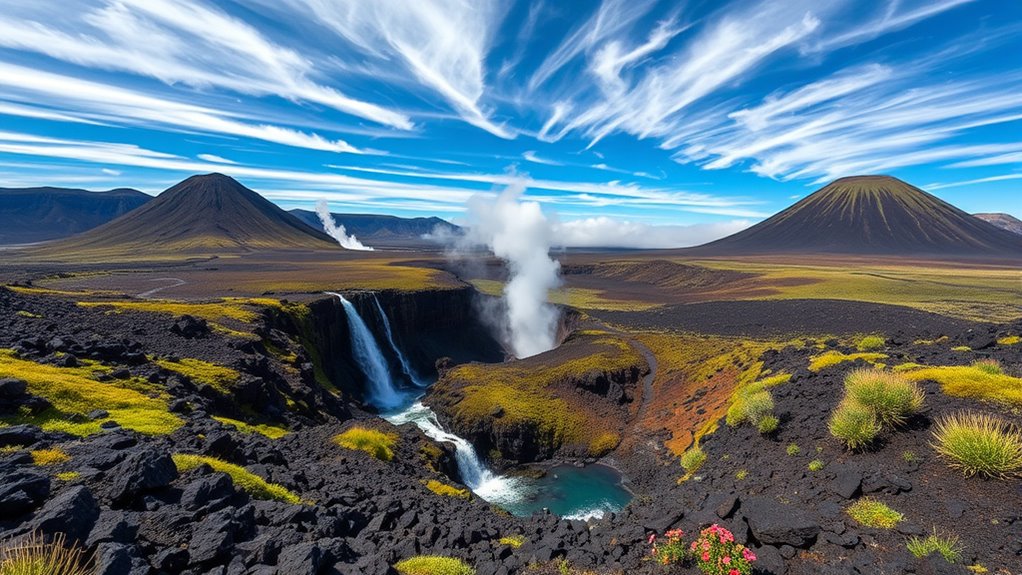
Nestled in central Oregon, the Newberry National Volcanic Monument offers a striking landscape shaped by ancient eruptions and flowing lava. As you explore, you’ll encounter vast lava fields that stretch across the terrain, creating a stark, otherworldly environment. These volcanic landscapes are the result of multiple eruptions over thousands of years, leaving behind hardened lava flows and unique formations.
- Walk along the Lava River Cave, a long underground tunnel formed by cooled lava.
- Marvel at the deep, glassy obsidian flows that sparkle in the sunlight.
- Visit the Big Obsidian Flow, where volcanic glass blankets the landscape in shimmering black.
This area vividly captures the power of volcanic activity, making it a must-see for geology enthusiasts and adventurers alike.
The Cascade Range: A Backbone of Natural Beauty
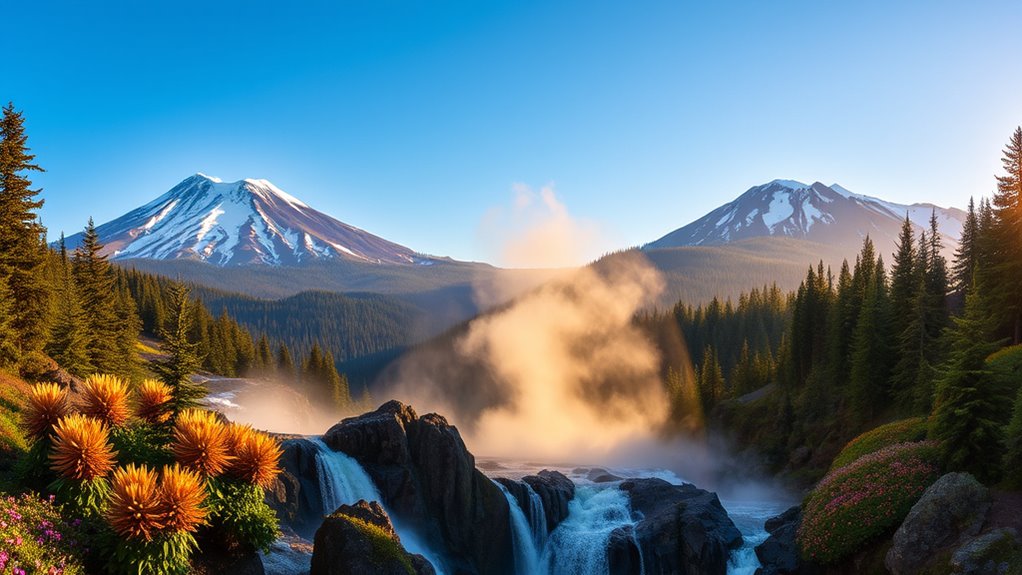
The Cascade Range stretches majestically through the Pacific Northwest, forming a rugged backbone of volcanic peaks, lush forests, and sparkling lakes. This range’s volcanic soil enriches the mountain ecosystems, supporting diverse plant and animal life. As you explore, you’ll notice how the volcanic activity has shaped the landscape, creating fertile ground for thriving forests and meadows. The mountain ecosystems here are resilient and vibrant, hosting coniferous forests, alpine meadows, and unique wildlife. These peaks serve as a natural barrier, influencing weather patterns and providing essential habitat for numerous species. Whether hiking through dense woods or gazing at snow-capped summits, you’ll experience the awe-inspiring beauty that makes the Cascade Range a true natural treasure of Oregon.
Wild Waterfalls of the Columbia River Gorge
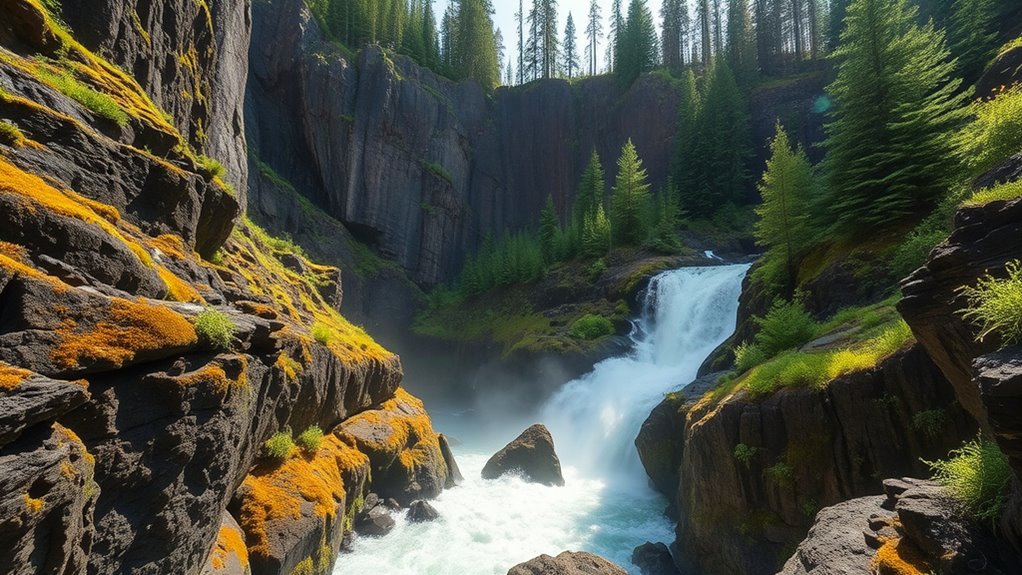
From the volcanic peaks and lush forests of the Cascade Range, your journey naturally flows into the stunning scenery of the Columbia River Gorge, where wild waterfalls cascade and carve their way through the rugged terrain. These waterfalls create vibrant ecosystems that support diverse plant and animal life. You’ll find prime spots for waterfall photography, capturing the power and beauty of these natural wonders. Popular waterfalls like Multnomah Falls and Horsetail Fall draw visitors enthusiastic to experience their spray and roar. Each waterfall offers a unique perspective on the gorge’s dynamic landscape. As you explore, you’ll witness the delicate balance of waterfall ecosystems thriving amid the mist and spray. These cascading waters not only enchant but also reveal the gorge’s essential ecological role.
Planning Your Route: Tips for an Unforgettable Circuit
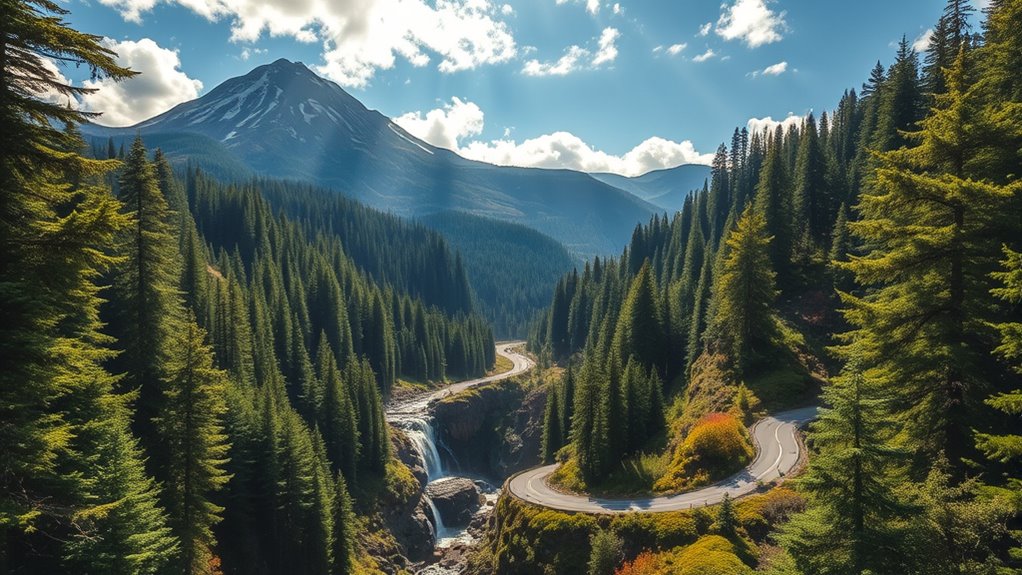
To make your Oregon volcanoes and waterfalls circuit truly unforgettable, start by mapping out a logical route that connects key attractions efficiently. Planning ahead helps you maximize your time and minimize backtracking, making the trip smoother and safer. Keep travel safety in mind—check road conditions and weather forecasts regularly, especially in remote areas. When visiting scenic spots, bring a camera, and remember photography tips like using a tripod for sharp images and capturing the golden hour for stunning light. Prioritize safety around waterfalls and volcanic terrains—stay on designated paths and heed warning signs. With a clear plan and attention to safety and photography, your circuit will be both memorable and worry-free.
Frequently Asked Questions
What Is the Best Time of Year to Visit Oregon’S Volcanoes and Waterfalls?
The best seasons to visit are spring and fall when crowds are smaller and weather is mild. Summer tends to be crowded, especially in popular spots, and winter can bring snow and limited access. You’ll enjoy fewer people, better scenery, and comfortable temperatures during the shoulder seasons. Planning your trip during these times helps you avoid crowded periods and fully appreciate Oregon’s stunning volcanoes and waterfalls.
Are There Guided Tours Available for the Volcanic and Waterfall Sites?
Imagine opening the secrets of nature’s masterpiece—guided tours await to lead you through Oregon’s volcanic wonders and waterfalls. At visitor centers, you’ll find expert-led excursions that deepen your connection to these majestic sites. Whether you seek the thrill of discovery or a peaceful journey, these guided tours make exploring easier and more meaningful. Embrace the adventure, knowing knowledgeable guides will reveal the stories behind every volcano and waterfall along your path.
How Accessible Are the Remote Waterfalls in Oregon’S Wilderness Areas?
You’ll find that remote access to waterfalls in Oregon’s wilderness areas varies, with some easily reachable trails and others requiring more adventurous wilderness exploration. Many remote waterfalls are accessible via well-maintained paths, but others demand off-trail navigation and good outdoor skills. Always prepare thoroughly, check trail conditions, and carry necessary gear to guarantee a safe experience while exploring Oregon’s secluded natural beauty.
What Safety Precautions Should Visitors Take Near Active Volcanic Regions?
When exploring active volcanic regions, you should prioritize volcano safety and eruption preparedness. Always check for official alerts and weather updates before your trip. Stay on designated trails, avoid restricted areas, and carry emergency supplies. Listen to local authorities and guides for instructions. Being cautious and well-informed helps you enjoy your adventure safely, minimizing risks associated with volcanic activity and ensuring you’re prepared for any unexpected eruptions.
Are There Family-Friendly Trails and Activities Along the Circuit Route?
Like a gentle stream flowing through a forest, the circuit offers family-friendly hikes and kid-friendly activities that suit all ages. You’ll find well-maintained trails perfect for little explorers and educational spots that spark curiosity. Many parks feature picnic areas and easy walks near waterfalls, making it easy to enjoy the scenery together. With a little planning, you and your family can have a memorable adventure filled with nature’s wonders and fun activities.
Conclusion
As you traverse Oregon’s volcanoes and waterfalls, you’ll feel like an explorer unraveling nature’s grand tapestry. Each site offers a unique story, from towering peaks to hidden cascades. Embrace the adventure with curiosity and awe, letting the landscape’s beauty inspire you. This circuit is like a precious gem, shimmering with natural wonders at every turn. So, pack your gear and get ready to create unforgettable memories in Oregon’s breathtaking wilderness.
